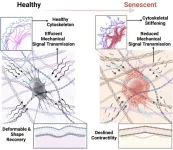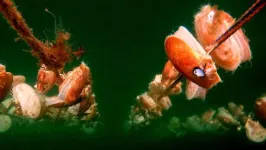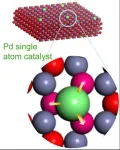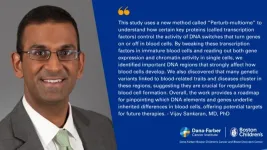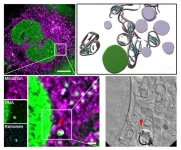(Press-News.org) It's no coincidence that our bodies feel a little creakier as we age. The trillions of cells that make up our skeleton age too, and some change in ways that weaken the very structure of our bones.
Scientists and researchers around the globe are investigating a series of mysteries about what happens to our bones over time. In a new study, a team led by The University of Texas at Austin, in collaboration with Mayo Clinic and Cedars-Sinai Medical Center just made a major break in the case. New research found that osteocytes undergo dramatic structural and functional changes with age that impair their ability to keep our bones strong. Their findings, published in Small and Aging Cell, offer new insights that could pave the way for better treatments for osteoporosis and age-related bone loss.
Aging and stress can induce cellular senescence in osteocytes, resulting in cytoskeletal and mechanical changes that impair their ability to sense mechanical signals, ultimately weakening bone.
Osteocytes are the master regulators of bone health, sensing mechanical forces and directing when to build or break down bone. But when exposed to senescent cells – damaged cells that stop dividing but don’t die – osteocytes themselves begin to stiffen. This cytoskeletal stiffening and altered plasma membrane viscoelasticity undermine their ability to respond to mechanical signals, disrupting healthy bone remodeling and leading to bone fragility.
"Imagine the cytoskeleton as the scaffolding inside a building," said Maryam Tilton, assistant professor in the Cockrell School of Engineering’s Walker Department of Mechanical Engineering and principal investigator of the study. "When this scaffolding becomes rigid and less flexible, the building can't adapt to changes and stresses, leading to structural problems. Similarly, stiffened osteocytes can't effectively regulate bone remodeling, contributing to bone loss."
Senescent cells release a toxic brew of molecules, called senescence-associated secretory phenotype (SASP), which triggers inflammation and damage in surrounding tissues. They've been linked to the development of cancer and many other chronic diseases. Until now, most research has focused on detecting senescence through genetic markers, a notoriously challenging task because these markers vary widely across cell types.
Tilton and her collaborators approach the issue from a different perspective, focusing on cell mechanics. Combining genetic and mechanical approaches could lead to improved treatments for aging cells.
“Much like physical therapy helps restore movement when our joints stiffen, we’re exploring how mechanical cues might help reverse or even selectively clear these aging cells,” Tilton said.
“In the future, biomechanical markers could not only help identify senescent cells but also serve as precise targets for eliminating them, complementing or offering alternatives to current drug-based senolytic therapies,” added Dr. James Kirkland, principal investigator of the National Institutes of Health Translational Geroscience Network, director at the Center for Advanced Gerotherapeutics at Cedars-Sinai and a co-leader of the new research.
Improved knowledge about how bones age could improve treatments for osteoporosis. The condition leads to weakened bones and an increased risk of fractures and affects millions of people worldwide, particularly those over the age of 50. As the global population ages, understanding the mechanisms behind bone deterioration becomes increasingly important.
The team plans to expand their research by exploring the effects of different stressors on osteocytes and investigating potential therapeutic interventions.
This project is led by Tilton in collaboration with Kirkland. Other co-authors on the project include Junhan Liao, Domenic J. Cordova, and Hossein Shaygani of the Walker Department of Mechanical Engineering; Chanul Kim of the Department of Biomedical Engineering; Maria Astudillo Potes from Mayo Clinic; and Kyle M. Miller of Emory University.
END
No bones about it: new details about skeletal cell aging revealed
2025-04-04
ELSE PRESS RELEASES FROM THIS DATE:
UNM scientists discover how nanoparticles of toxic metal used in MRI scans infiltrate human tissue
2025-04-04
University of New Mexico researchers studying the health risks posed by gadolinium, a toxic rare earth metal used in MRI scans, have found that oxalic acid, a molecule found in many foods, can generate nanoparticles of the metal in human tissues.
In a new paper published in the journal Magnetic Resonance Imaging, a team led by Brent Wagner, MD, professor in the Department of Internal Medicine in the UNM School of Medicine, sought to explain the formation of the nanoparticles, which have been associated with serious health problems in the kidneys and other organs.
“The worst disease caused by MRI contrast agents is nephrogenic systemic ...
UMaine research examines best methods for growing Atlantic sea scallops
2025-04-04
A new study from the University of Maine’s Aquaculture Research Institute (ARI) and Darling Marine Center is helping to refine best practices for growing Atlantic sea scallops (Placopecten magellanicus), a species of increasing interest to Maine’s aquaculture sector.
Published in the academic journal Aquaculture, the research compares two scallop farming methods, ear-hanging and lantern net culture, over a complete grow-out cycle to determine which approach yields the best results for commercial growers. The study, led by UMaine ...
Medical cannabis could speed recovery, especially at community recovery homes
2025-04-04
A new pilot study from UBC Okanagan and Thompson Rivers University examined how medically supervised cannabis use in a residential recovery home may support people in treatment for substance use challenges.
Participants reported that cannabis helped them manage pain, anxiety, depression and sleep issues—key symptoms that can complicate recovery.
"Our findings suggest medical cannabis could play a meaningful role in reducing cravings and improving retention in recovery programs," says ...
Study assesses U.S. image amid weakening of democracy
2025-04-04
The erosion of democracy in the U.S. has been a topic of concern in recent years, especially after protesters stormed the U.S. Capitol on Jan. 6, 2021, in an attempt to block the certification of Joe Biden's election as president. Most of the academic studies on democratic backsliding, however, have focused on public opinion within the U.S. and have not looked at global public opinion.
How favorably others view the U.S. is part of the country's "soft power"—a term coined by Joseph Nye at Harvard University in the 1980s. It refers to a country's ability to influence other countries’ policy ...
Two scientific researchers to receive 2025 Ralph L. Sacco Scholarships for Brain Health
2025-04-04
DALLAS and MINNEAPOLIS, April 4, 2025 — The American Academy of Neurology and the American Heart Association have awarded the 2025 Ralph L. Sacco Scholarships for Brain Health to two researchers, Hortense Triniac, Ph.D., of Milwaukee and Katy Walsh, Ph.D., of Boston. Each will receive a $150,000 two-year scholarship to support continuing scientific research in brain health. This is the second year this scholarship has been awarded.
The Ralph L. Sacco Scholarships in Brain Health, also known as the Sacco Scholars program, are made possible by a generous bequest to the American Academy of Neurology, the world’s largest association of neurologists ...
Researchers improve chemical reaction that underpins products from foods to fuels
2025-04-04
CORVALLIS, Ore. – A chemical reaction that’s vital to a range of commercial and industrial goods may soon be initiated more effectively and less expensively thanks to a collaboration that included Oregon State University College of Engineering researchers.
The study, published in Nature, involves hydrogenation – adding the diatomic hydrogen molecule, H2, to other compounds.
“Hydrogenation is a critical and diverse reaction used to create food products, fuels, commodity chemicals and pharmaceuticals,” ...
Texas Tech to develop semiconductor power devices through $6 million grant
2025-04-04
Summary:
Texas Tech University’s Edward E. Whitacre Jr. College of Engineering has secured a $6 million U.S. Department of Defense grant to develop advanced semiconductor materials and devices, particularly for high-power electronics and optoelectronics. The project aims to enhance the performance of wide and ultra-wide bandgap semiconductors, leading to more reliable, high-performance electronics for military applications.
Why This Matters:
Technology Advancement: The research will improve the development of high-performance, high-power electronic devices critical for modern technologies.
Military/Defense Applications: The project targets key military systems, ...
Novel genomic screening tool enables precision reverse-engineering of genetic programming in cells
2025-04-04
RESEARCH SUMMARY
Novel genomic screening tool enables precision reverse-engineering of genetic programming in cells
Study Title: Transcription factor networks disproportionately enrich for heritability of blood cell phenotypes
Publication: Science
Corresponding Dana-Farber Cancer Institute authors: Alexis Caulier, MD, PhD, Vijay Sankaran, MD, PhD
Summary: Collaborative research led by investigators at Dana-Farber/Boston Children's Cancer and Blood Disorders Center defines a ...
Hot Schrödinger cat states created
2025-04-04
Quantum states can only be prepared and observed under highly controlled conditions. A research team from Innsbruck, Austria, has now succeeded in creating so-called hot Schrödinger cat states in a superconducting microwave resonator. The study, recently published in Science Advances, shows that quantum phenomena can also be observed and used in less perfect, warmer conditions.
Schrödinger cat states are a fascinating phenomenon in quantum physics in which a quantum object exists simultaneously in two different states. In Erwin Schrödinger's thought experiment, it is a cat that is alive ...
How cells repair their power plants
2025-04-04
Damage to the genetic material of mitochondria – the mitochondrial DNA or mtDNA for short – can lead to diseases such as Parkinson’s, Alzheimer’s, amyotrophic lateral sclerosis (ALS), cardiovascular diseases and type 2 diabetes. Such damage also speeds up the ageing process. However, the cells are normally capable of identifying such damage and reacting.
Scientists from University Hospital Düsseldorf and HHU have – in collaboration with the University of Cologne and the Center for Molecular Medicine Cologne (CMMC) – discovered a mechanism, which protects and repairs the mitochondria. The research ...
